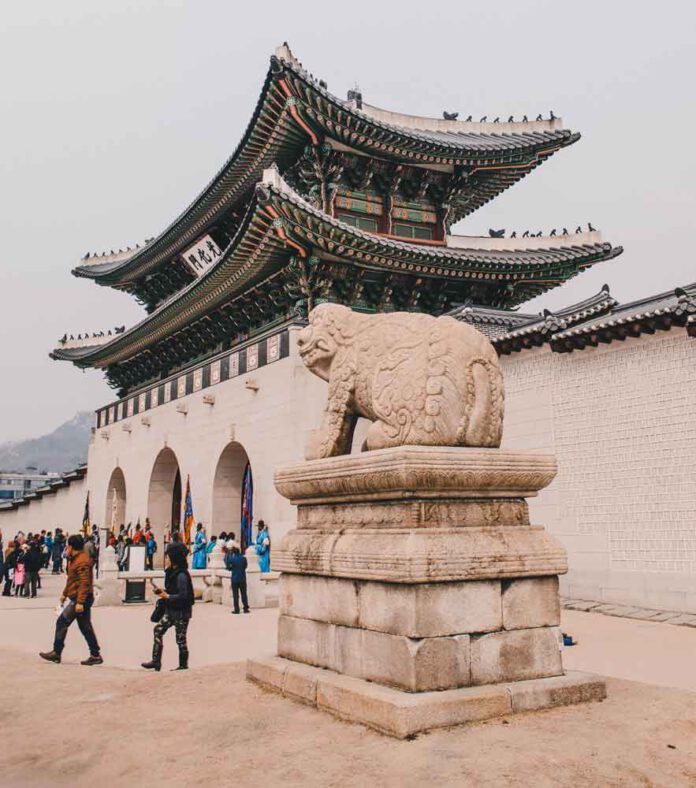My passion for travel, especially in Asia, led me to Korea, more precisely, to Seoul. As early as the 9th century, Arab merchants discovered Korea: “Behind China lies a country called Silla, where there is an abundance of gold.” In the 21st century, Seoul has not lost any of its fascination.
The Gangam-Gu district, the traditional market in Insa-dong, and the Gyeongbokgung Palace are just a few of the places to see in Seoul. Seoul is a delight day and night, just like its gastronomy. I will share addresses and culinary specialties that have made K-Food famous.
Incheon. The Seoul airport, voted the best in the world, already hints at a hospitable country: A very comfortable bus awaits at the exit. Outside, the landscape passes by: pine-covered hills, sea bays, endless bridges. Then the settlements become denser. Buildings as far as the eye can see, giant screens on glass skyscrapers contrasting with palaces, teahouses, and the diverse, generous, and delicious Korean cuisine.
A National Symbol
Kimchi: the ultimate traditional Korean specialty! It can be found everywhere. Resembling spicy sauerkraut, the basic recipe consists of cabbage and numerous spices (ginger, chili, garlic…). Its uniqueness lies in its many recipe variations. This dish, invented 2000 years ago, is first soaked in saltwater, then fermented, increasing its mineral, protein, and calcium content. It is considered one of the five healthiest dishes in the world. The making of Kimchi was added to UNESCO’s list of intangible cultural heritage in 2013. Koreans practically eat it with every meal. For Koreans, Kimchi is what baguette is for the French.
Korean Barbecue
At the globally renowned Korean barbecue, you can choose your piece of meat and grill it directly on a grill in the middle of the table. The Samgyopsal variant with pork belly is widespread. The pro grills the onions first, then the garlic and chopped vegetables, and finally the meat so that the meat juices run over the vegetables. Once everything is cooked, the meat and vegetables are wrapped in a lettuce leaf, dipped in sauce, and eaten. This little wrap is devoured in one bite. The best barbecue is here: 853 16, Insa-dong 12-gil, Jongno-gu Near By Samjigil.
Street Food
Korean cuisine fits perfectly with the street food trend, which I discovered mainly at the Gwangjang market, the first market in Korea founded in 1905. There is almost everything on offer, clothes, kitchen utensils, fruits, and vegetables. The sellers create a pleasant atmosphere and skillfully stage the preparation of their specialties, including Bindaetteok (a type of pancake made from mung beans, pork or beef, and Kimchi) and Gimbap (rice and ingredients rolled in a dried seaweed, a kind of Korean Maki). I particularly enjoyed the Mandu or Mandoo, small steamed ravioli. They are also available fried or grilled. The term “Mandoo” comes from the shape and the dough made of flour, salt, and water. They go well with vegetables, shrimp, meat, and of course Kimchi. Simply delicious! What would street food be without the famous squid salads and fried or dried squid rings? These sea delicacies are served in small paper cups and seasoned simply with lemon juice.

A Complete Dish
Another flagship of local gastronomy is Bibimbap, a dish with rice, spinach, bean sprouts, cucumber, zucchini, and optionally a fried egg, beef, or minced meat, served with a spicy sauce and sesame oil. The dish gained worldwide fame when Michael Jackson declared himself a big Bibimbap fan!
Sipping a Tea
The districts of Insa-dong and Samcheong-dong have many teahouses, often hidden on the second floor of traditional, restored houses. People usually sit on the floor there. Everyone loves Omija-cha tea, my favorite place is the quince tea at Yechajip.
1st Floor, 33-1 Insadong-gil, Jongno-gu; Tel.: 7225332
Eternal Ice
At the end of a small alley in the Buckhon district, a former village with traditional houses, this small tea room hides with an old-fashioned, almost kitschy style. Here you can find Bingsu, the typical dessert

